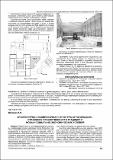| dc.contributor | Брестский государственный технический университет | ru_RU |
| dc.contributor | Brest State Technical University | ru_RU |
| dc.contributor.author | Малков, Игорь Игоревич | |
| dc.coverage.spatial | Брест | ru_RU |
| dc.date.accessioned | 2020-12-30T08:34:47Z | |
| dc.date.available | 2020-12-30T08:34:47Z | |
| dc.date.issued | 2008 | |
| dc.identifier.citation | Малков, И. И. Архитектурно-планировочная структура агрогородков – отражение преемственности традиций и новых социально-экономических условий / И. И. Малков // Вестник Брестского государственного технического университета. Серия: Строительство и архитектура. – 2008. – № 1. – С. 15–19 : ил. – Библиогр.: с. 19 (4 назв.). | ru_RU |
| dc.identifier.uri | https://rep.bstu.by/handle/data/9767 | |
| dc.description | MALKOV I. I. Architectural - lay-out structure agrarian settlement - reflection of continuity of traditions and new socio economic conditions | ru_RU |
| dc.description.abstract | Статья посвящена принципам архитектурно-планировочной организации населенных мест нового типа. В статье обобщен опыт формирования населенных пунктов на примере Гомельского района, а также других населенных мест Гомельской области. Анализ построен на конкретных примерах застройки. | ru_RU |
| dc.language.iso | ru | ru_RU |
| dc.publisher | БрГТУ | ru_RU |
| dc.relation.ispartofseries | Строительство и архитектура; | |
| dc.subject | сельские жилые дома | ru_RU |
| dc.subject | rural residential buildings | ru_RU |
| dc.title | Архитектурно-планировочная структура агрогородков – отражение преемственности традиций и новых социально-экономических условий | ru_RU |
| dc.type | Статья (Article) | ru_RU |
| dc.identifier.udc | 728.8(476) | ru_RU |
| dc.abstract.alternative | Clause is devoted to principles architectural - lay-out organizations of the occupied places of a new type. In clause the experience formations of the occupied places on an example of the Gomel area, and also other occupied places of the Gomel area is generalized. The analysis of formation of the occupied places is constructed on concrete examples of building of the occupied places. | ru_RU |
